US retail sales unexpectedly jump in June
US retail sales jumped 0.6% in June from downwardly revised 1.7% drop in May, while economists forecasted decline of 0.4%.
Unexpected increase was boosted by persisting strong demand for goods, despite spending was shifted to services and sales of motor vehicles declined on supply disruptions, as low interest rates, massive fiscal stimulus and improved health situation underpinned retail sales.
Compared to the same period last year, sales rose 18% and surpassed pre-pandemic levels.
While demand for goods and motor vehicles was strong during Covid crisis, spending is now returning to services – travelling, accommodation and entertainment.
Goods remain the main component of retail sales, followed by travel and hotel accommodation, healthcare, education, which make up the remaining part of consumer spending.
The biggest increase was registered in sales in restaurants and bars, followed by furniture, electronics and appliances sales, as well as building materials, while sales of sporting goods, musical instruments and books declined last month.
So-called core retail sales which exclude autos, gasoline and food rose 1.1% in June compared to 1.4% drop in May, adding to positive signals.
Consumer spending, which accounts for more than two thirds of US economic activity, to rise further and reach double-digit growth in the second quarter, as US households accumulated at least $2.5 trillion in excess savings during the pandemic, which is expected to drive spending in coming months.


